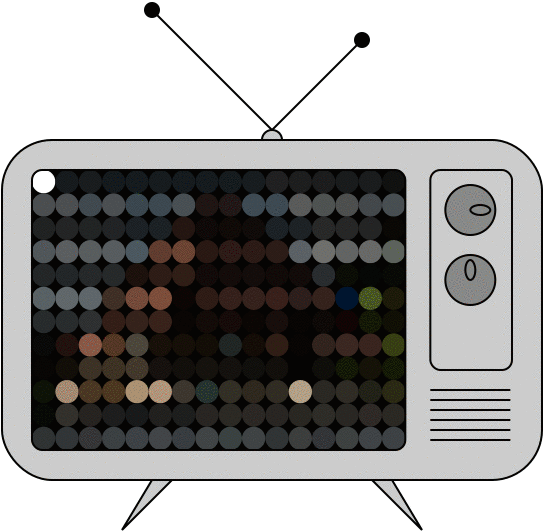How are you reading this article? There's a very good chance that you're using a monitor to read this article. Did you know how many different types of technologies are used, and have been used, for displaying content. If you're reading this on a phone, there's a good chance you're using an OLED display, while your computer monitor is most likely a TN LCD display. Don't worry, we'll go over those terms below.
CRT
While there are plenty of display technologies, I'm gonna start with the CRT – Cathode Ray Tube. Those giant, heavy monitors and TVs that you often find for cheap or free on Craigslist. They've been around for a very long time, with the first commercial CRT TV becoming available in 1934. The first mass produced color TV – the RCA CT-100 – was available in 1954. CRTs use an electron gun to light up phosphors arranged on the inside of the glass you view to create an image. The color CRT TVs used three electron guns, red, blue, and green, to create color. The electron gun would start at the top of the screen and move from left to right (if you were facing the screen), and light up the phosphors to display the image. The phosphors don't stay lit for very long, so the electron gun would actually skip every other row before returning to the top of the screen. This technique is called interlacing and it basically tricks our eyes into thinking that we're seeing the full picture every frame.
CRTs' advantages are that they look good with any resolution, and have very fast response times. The "pixels" of a CRT are not perfectly square, and this could be an advantage depending on your point of view. CRTs' disadvantages are that they are very large, very heavy, and the dangers involved with the vacuum sealed, high voltage cathode ray. Starting in the early 2000's, CRTs were being replaced by Plasma TVs and LCD TVs and monitors. Today, CRTs mostly fulfill a niche for retro video gaming.
LCD
Liquid Crystal Display TVs and monitors were much smaller, and lighter, and used less power. LCD panels have a layer of liquid crystals between glass that lets light pass through it to display an image. Because they did not produce their own light, backlights were required. LCD TVs originally used a cold cathode fluorescent light as its backlight source, but these have been replaced with LED backlights because they are cheaper, slimmer, and use less power. However, there are three different types of LCD panels commonly found: Twisted Nematic (TN), In-Plane Switching (IPS), and Vertical Alignment (VA). These refer to how the liquid crystals are configured to block or allow light and it affects color, viewing angles, and refresh rate, and more.
TN panels were the first panel to really drive down the cost of LCD panels and make them more accessible. TN panels are noted for their fast response times and high refresh rates, and are probably the most common type of LCD panel. IPS panels are noted for their color reproduction and extremely wide viewing angles (178°) without color or contrast degradation. IPS panels make for great computer monitors, especially for professionals who need color accuracy. VA panels are noted for deeper blacks, and contrast ratio, than TN or IPS panels, and are mostly found in TVs. Black text can smear on VA panels, making them less ideal for computer monitor usage. TN panels can still achieve higher refresh rates than IPS or VA panels, so if a 240 Hz display doesn't refresh fast enough, you'll have to sacrifice color quality and use a TN panel.

Plasma
At the same time LCD TVs were replacing CRT TVs, large HD Plasma screens TVs were becoming popular as well. Plasma TVs offered some advantages over its LCD counterparts: darker blacks, wider viewing angles than TN panels, and a high internal refresh rate that reduced motion blur. However, Plasma TVs used more power than LCD TVs and were at risk for burn-in, where a static image (such as a news logo) would be permanently visible on the TV. By 2014, most TV manufacturers had ceased production of new Plasma TVS, as they had shifted their attention to OLED panels.
OLED
Organic Light-Emitting Diodes are panels where each pixel is its own light source and each individual pixel can be turned on or off, independent of its neighbors. This leads to true blacks without any light being emitted at all, while LCD panels would still need a backlight for other parts of the scene. Since less light is needed for darker scenes, OLED panels use less power than LCD panels for dark scenes, but can use more power for bright white scenes. OLED panels are commonly used in mobile displays (Samsung produces a lot of OLED panels that it uses in their own phones and others), and in high end TVs. OLED panels do not lend themselves well to computer monitors because they suffer from increased burn-in risk, like Plasma, so the static UI elements of a desktop experience are the exact things an OLED panel should avoid. As each pixel group of red, green, and blue LEDs emits light, they slowly start to degrade (but faster with higher brightness), and this degradation of each pixel at different rates (with the blue subpixel degrading the fastest) leads to burn-in.







Top comments (2)
It’s interesting to see how display tech has evolved, especially reading about CRTs and LCDs. Lately, I was curious if my monitor was showing everything correctly, so I ran a screen test using this site: allcolorscreen.com/black-screen. The black screen helped me spot a couple of stuck pixels and subtle brightness inconsistencies that I hadn’t noticed before. It made me realize how important it is to check your screen regularly, especially with so many types of displays around. Keeping an eye on those details definitely improves my viewing experience.
This is really superb information!!! tahajjud for love back